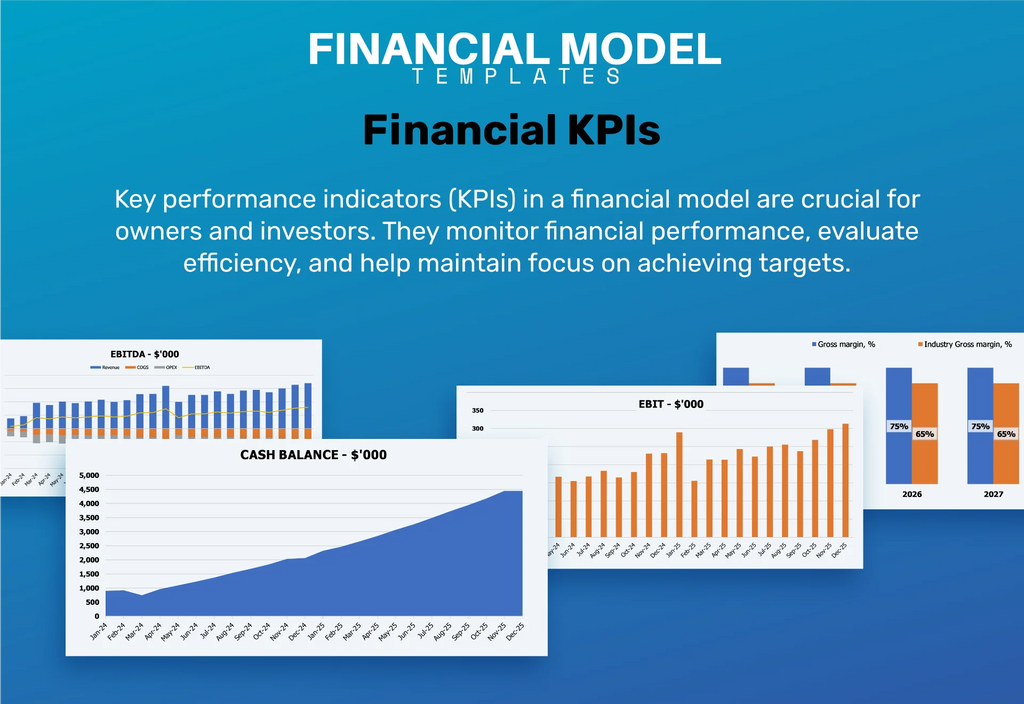Warehouse Automation Financial Model

- ✔ 5-Year Financial Projections
- ✔ 100% Editable
- ✔ Investor-Approved Valuation Models
- ✔ MAC/PC Compatible, Fully Unlocked
- ✔ No Accounting Or Financial Knowledge
Warehouse Automation Financial Model
Bundle Includes:
ALL IN ONE MEGA PACK - CONSIST OF:
warehouse automation Financial Model/Business Plan Excel Template
Pitch Deck Template For PowerPoint, Keynote & Google Slides
Business Plan Guide and Business Plan Template in MS Word Format
Financial Dashboard in Excel To Track Your Business Performance
WAREHOUSE AUTOMATION FINANCIAL MODEL FOR STARTUP INFO
Highlights
This highly versatile and user-friendly warehouse automation five-year projection plan is designed to enhance your financial forecasting in logistics, allowing businesses to prepare accurate income statements, cash flow forecasts, and balance sheets with both monthly and annual timelines. Ideal for startups or existing warehouse automation enterprises, this financial plan facilitates a comprehensive cost-benefit analysis of automation, focusing on capital investment in automation and the financial impact of robotics on warehouse operational expenses. By integrating supply chain efficiency metrics and evaluating warehouse performance indicators, it supports effective budgeting for logistics automation while emphasizing strategies for warehouse labor cost reduction and inventory turnover rates. Unleash the potential of automated inventory management and automated order fulfillment to optimize your warehousing processes while maximizing the return on investment in automation.
The financial model template addresses critical pain points for startups in warehouse automation by providing a comprehensive cost analysis that encompasses warehouse operational expenses, labor cost reduction, and capital investment in automation. By integrating supply chain efficiency metrics and automated inventory management insights, users can effectively evaluate the return on investment in automation and project financial forecasting in logistics with enhanced accuracy. The template facilitates a thorough cost-benefit analysis of automation, allowing potential investors to grasp the financial impact of robotics on inventory turnover rates and warehouse performance indicators. Additionally, it supports logistics automation budgeting strategies, ensuring that users can implement lean warehousing practices while understanding the total cost of ownership, ultimately enhancing decision-making and strategic planning for their venture.
Description
This warehouse automation financial projection provides a robust framework for assessing the feasibility of initiating or upgrading warehouse automation, offering a five-year financial forecast grounded in historical performance coupled with future assumptions. Designed for in-depth financial analysis, it encompasses essential metrics such as warehouse operational expenses, inventory turnover rates, and cost-benefit analysis of automation, enabling stakeholders to gauge supply chain efficiency metrics and the financial impact of robotics on labor cost reduction. The model includes a comprehensive summary of three financial statements—pro forma income statement, projected balance sheet, and cash flow statement—while calculating key indicators such as Free Cash Flows, Internal Rate of Return, and break-even analysis, facilitating accurate capital investment in automation and enhanced financial forecasting in logistics. Ultimately, this tool empowers users to optimize technologies adopted in logistics, offering insights into the total cost of ownership in warehousing and aligning with lean warehousing strategies for improved warehouse performance indicators.
WAREHOUSE AUTOMATION FINANCIAL MODEL REPORTS
All in One Place
Our comprehensive warehouse automation financial projection template equips you with essential insights for your investor meetings. This Excel model details key aspects such as financial assumptions, standardized financial statements, and precise calculations for a five-year cash flow forecast. With a focus on cost-benefit analysis of automation, return on investment in robotics, and efficiency metrics in warehousing, this tool enhances your capacity for effective financial forecasting in logistics. Elevate your discussions on warehouse operational expenses and capital investment in automation while showcasing the financial impact of technology adoption in logistics.

Dashboard
Transform your financial insights with our comprehensive business revenue model template. Gain a clear overview of key performance indicators, such as warehouse automation cost analysis, inventory turnover rates, and supply chain efficiency metrics. Our engaging charts not only showcase your financials but also highlight the impact of robotics and automated inventory management on reducing operational expenses. Ready to elevate your logistics automation budgeting? Copy and paste directly into your presentation for a compelling and professional overview that demonstrates the return on investment in automation and the benefits of lean warehousing strategies.

Business Financial Statements
Business owners and stakeholders must grasp the three core financial statements to effectively analyze company performance. Each document highlights crucial financial metrics, offering a comprehensive view of the organization's financial health. The pro forma income statement reveals insights into operational activities driving earnings, while the pro forma balance sheet and cash flow projection emphasize capital management, asset allocation, and structural integrity. Integrating these insights helps in making informed decisions regarding warehouse automation cost analysis, automated inventory management, and ultimately enhancing supply chain efficiency metrics for better profitability and return on investment in automation.

Sources And Uses Statement
To enhance tracking of funding sources and planned expenditures, our model includes a dedicated "Use of Funds" tab. This section clearly delineates the funding sources and their intended applications within the organization. By implementing effective financial modeling for supply chains, businesses can improve warehouse performance indicators and logistics automation budgeting. This strategic approach supports efficient capital investment in automation, ultimately driving warehouse operational expenses down and maximizing return on investment in automation, as well as aligning with lean warehousing strategies for enhanced supply chain efficiency metrics.

Break Even Point In Sales Dollars
Breakeven analysis is essential for assessing when your business covers all expenses and moves into profitability. To perform this analysis, identify both fixed and variable costs. Fixed costs, such as rent and administrative salaries, remain constant irrespective of sales volumes, often termed overhead expenses. Conversely, variable costs fluctuate with sales, encompassing expenses like inventory purchases, shipping, and manufacturing. Implementing insights from this analysis can enhance warehouse operational efficiency, inform capital investment in automation, and optimize logistics strategy, ultimately improving return on investment in automation efforts.

Top Revenue
Topline growth, representing a company's revenue or gross sales, is crucial for financial forecasting in logistics. Investors and analysts focus on these key performance indicators, as they significantly influence profitability and EBITDA. Monitoring trends in revenue and profits, stakeholders assess the financial impact of robotics and warehouse automation. Enhanced supply chain efficiency metrics and automated inventory management contribute to effective cost-benefit analysis of automation, driving warehouse labor cost reduction and optimizing operational expenses. Ultimately, increased revenue leads to improved overall financial performance, underscoring the importance of strategic capital investment in automation and lean warehousing strategies.

Business Top Expenses Spreadsheet
The expense summary offers a detailed breakdown of your operational costs, essential for effective financial forecasting in logistics. By categorizing expenses, you can strategically plan for warehouse automation development and capital investment in automation. Utilize this report for three-year financial projections, allowing for real-time adjustments to meet efficiency metrics in warehousing. Regular monitoring of expenses against expectations ensures informed decision-making, optimizing warehouse labor cost reduction and enhancing overall supply chain efficiency. Embracing lean warehousing strategies and automated inventory management will improve your return on investment in automation and elevate warehouse performance indicators.

WAREHOUSE AUTOMATION FINANCIAL PROJECTION EXPENSES
Costs
To excel in today’s competitive landscape, proactive cost and expenditure planning is crucial, particularly concerning startup costs in warehouse automation. Our finance forecasting model features specialized Pro-forma templates that enable clear visibility into funding versus expenditures, ensuring efficient capital investment decisions. This vigilance helps mitigate financial deficits and optimize resource allocation. By leveraging our financial modeling for supply chains, organizations can enhance supply chain efficiency metrics, streamline automated inventory management, and ultimately improve return on investment in automation, driving sustainable growth in logistics. Embrace technology adoption in logistics to elevate your operational performance.

CAPEX Spending
Capital expenditure (CapEx) is essential for effective financial forecasting in logistics, serving as the budget for acquiring, upgrading, and maintaining physical assets like property, plants, and equipment (PPE). When analyzing warehouse operational expenses, it’s crucial to consider development costs for depreciation management. An effective start-up budget calculation, particularly in finance leasing, ensures that the value of assets correlates with automated inventory management and warehouse optimization goals. By integrating these financial metrics into your strategy, you can enhance supply chain efficiency and evaluate the return on investment in automation initiatives, leading to improved warehouse performance indicators.

Loan Financing Calculator
Optimize your financial management with our Excel template, featuring a comprehensive loan amortization schedule located in the 'Capital' tab. This tool streamlines your financial modeling for supply chains by incorporating pre-built formulas for precise calculations of loans, interest, and equity. Utilizing this template enhances supply chain efficiency metrics and supports informed decision-making in capital investment in automation. Elevate your approach to financial forecasting in logistics and navigate your warehouse operational expenses with confidence. Embrace technology adoption in logistics to maximize your return on investment in automation.

WAREHOUSE AUTOMATION EXCEL FINANCIAL MODEL METRICS
Financial KPIs
Utilizing financial key performance indicators (KPIs) can significantly enhance your company's performance and financial health. This warehouse automation business plan template offers a robust framework for projecting financial outcomes, presenting key metrics through dynamic charts. By incorporating analytics on warehouse operational expenses, inventory turnover rates, and the return on investment in automation, businesses can effectively conduct a cost-benefit analysis of automation. Embrace technology adoption in logistics to refine supply chain efficiency metrics, optimize operations, and ultimately achieve significant labor cost reductions while enhancing order fulfillment processes.

Cash Flow Forecast Excel
A cash flow statement provides a comprehensive overview of your business's cash usage over a specific period, detailing all inflows and outflows. This financial tool is essential for warehouse automation cost analysis, enabling informed decision-making regarding capital investment in automation. By understanding operational expenses and cash flow, businesses can enhance supply chain efficiency metrics and evaluate the return on investment in automation technologies. Ultimately, it supports effective financial forecasting in logistics and aids in implementing lean warehousing strategies for improved inventory turnover rates and overall warehouse performance.

KPI Benchmarks
The business plan financial projections template with a benchmark tab is essential for evaluating a company's financial potential and performance. By analyzing industry averages, especially for startups unfamiliar with logistics and supply chain dynamics, it highlights key efficiency metrics and operational expenses. This comprehensive cost-benefit analysis empowers businesses to identify strengths and weaknesses in areas like automated inventory management and robotics in warehouse optimization. Emphasizing financial modeling for supply chains and return on investment in automation guides strategic decisions, ensuring informed progress in warehouse labor cost reduction and technology adoption in logistics.

P&L Statement Excel
The Profit and Loss Statement provides valuable insights into your warehouse automation's financial health, detailing key revenue streams and expense categories. This essential document allows stakeholders to evaluate profitability, operational efficiency, and debt repayment capabilities. By utilizing the template’s forecasting features, you can conduct a comprehensive cost-benefit analysis of automation initiatives, assess return on investment, and enhance financial modeling for supply chains. It’s a crucial tool for driving supply chain efficiency metrics and optimizing warehouse performance indicators, ultimately supporting better decision-making in logistics automation budgeting and capital investment in automation.

Pro Forma Balance Sheet Template Excel
The projected balance sheet template provides a comprehensive view of a company's assets and liabilities, while the profit and loss forecast (P&L) details operational and financial performance over time. For startups, a pro forma balance sheet highlights net worth, distinguishing between equity and borrowed capital. Essential indicators such as liquidity, solvency, and turnover rates are crucial for assessing supply chain efficiency and warehouse performance. Integrating financial modeling for supply chains supports strategic decision-making, ensuring effective capital investment in automation and cost-benefit analysis of logistics, ultimately enhancing inventory turnover and warehouse operational expenses.

WAREHOUSE AUTOMATION FINANCIAL PROJECTION TEMPLATE VALUATION
Startup Valuation Model
The valuation report template within this financial model business plan enables users to conduct a detailed discounted cash flow valuation. By adjusting key rates in the cost of capital, organizations can assess the financial impact of automation initiatives, including warehouse labor cost reduction and capital investment in automation. This analysis aids in understanding return on investment in automation and optimizing supply chain efficiency metrics. Incorporating this tool facilitates comprehensive financial modeling for supply chains, ensuring informed decision-making toward lean warehousing strategies and enhanced warehouse operational expenses management.

Cap Table
A capital table is essential for modeling a company’s equity structure, clarifying the share of each investor. This tool offers a comprehensive view of the organization’s financial resources, which is crucial in today’s competitive landscape. Analyzing warehouse automation cost and utilizing efficiency metrics in warehousing can significantly enhance operational performance. By understanding the financial impact of robotics and conducting a thorough cost-benefit analysis of automation, businesses can make informed decisions on capital investment in automation, ultimately driving supply chain efficiency and optimizing inventory turnover rates.

KEY FEATURES
A robust financial modeling approach enhances supply chain efficiency metrics, optimizing warehouse performance and ensuring effective capital investment in automation.
Implementing a robust financial model for warehouse automation enables precise forecasting, ensuring sustainable growth and minimizing financial risk.
A robust financial model in logistics enhances supply chain efficiency by optimizing warehouse operational expenses and improving inventory turnover rates.
Implementing a financial model for warehouse automation ensures informed decisions, maximizing efficiency while minimizing risks and costs.
Implementing a robust financial model enhances decision-making by accurately assessing the return on investment in warehouse automation initiatives.
Leverage financial modeling to confidently evaluate investments in warehouse automation versus labor, optimizing cash flow and operational efficiency.
Implementing financial modeling for supply chains enhances decision-making by evaluating the return on investment in automation strategies effectively.
A robust financial model enables precise forecasting, allowing businesses to evaluate the impact of automation on cash flow dynamics effectively.
A robust financial model for warehouse automation reveals significant cost reductions and enhances supply chain efficiency metrics, ensuring strategic capital investment.
A robust financial model for warehouse automation showcases significant return on investment while enhancing supply chain efficiency metrics and reducing costs.
ADVANTAGES
Utilizing a warehouse automation financial model enables precise cost analysis, enhancing supply chain efficiency and supporting informed asset acquisition decisions.
A robust financial model for warehouse automation enhances decision-making by accurately analyzing costs and maximizing return on investment.
The financial model for warehouse automation enables precise cost analysis, maximizing investment returns and enhancing supply chain efficiency metrics.
Financial modeling for logistics enhances decision-making by evaluating the cost-benefit analysis of automation and optimizing supply chain efficiency.
A robust financial model for warehouse automation predicts cost savings, enhancing supply chain efficiency and reducing operational risks over five years.




